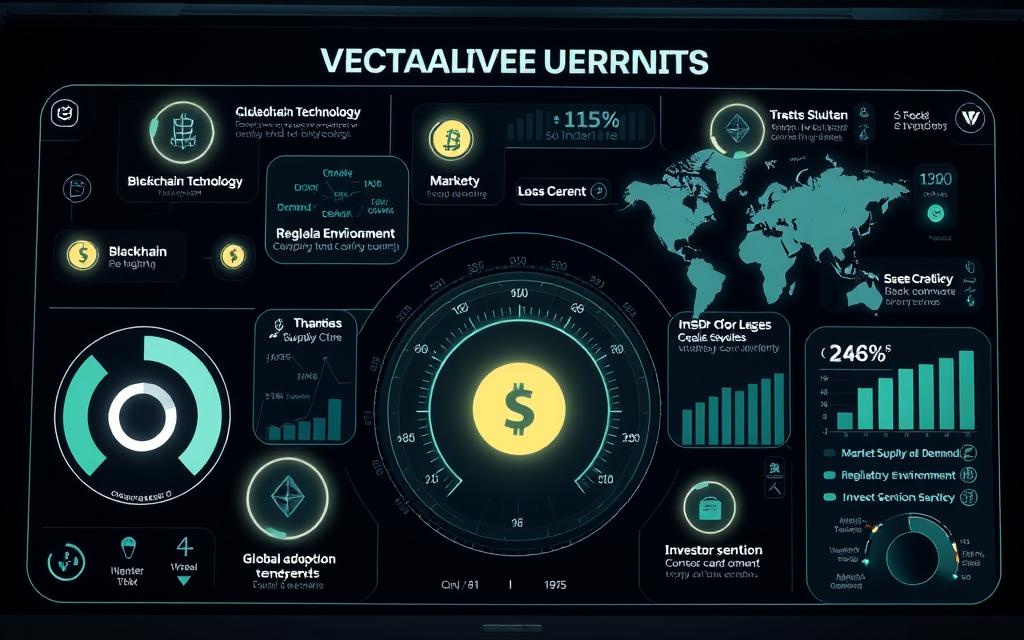Cryptocurrency operates differently from traditional fiat currencies. Unlike government-backed money, its price is influenced by unique factors like scarcity, utility, and market dynamics. For example, Bitcoin’s 21 million supply cap ensures limited availability, a key driver of its worth.
Investopedia outlines six attributes that define a currency: scarcity, divisibility, acceptability, portability, durability, and uniformity. Cryptocurrencies like Bitcoin excel in these areas, making them both functional and valuable. Over time, Bitcoin’s price has surged from less than $1 to over $75,000, showcasing the power of market forces.
Research from Fidelity Digital Assets highlights declining Bitcoin volatility, signaling its growing maturity as an asset. Today, cryptocurrency serves dual purposes: a payment method and a speculative investment. Understanding these factors helps explain its evolving role in the global economy.
Introduction to Cryptocurrency Valuation
The foundation of cryptocurrency’s worth lies in its innovative structure. Unlike traditional money, which relies on government backing, digital assets derive their value from technology and scarcity. Bitcoin, for example, meets all the criteria of a currency: scarcity, divisibility, acceptability, portability, durability, and uniformity.
Historically, societies used shells, gold, and other commodities as money. Today, cryptocurrencies like Bitcoin offer a digital alternative with added advantages. Bitcoin’s 8-decimal divisibility and borderless transactions make it more versatile than traditional currency.
Fiat currencies face challenges like inflation and centralization. Cryptocurrencies address these issues by being decentralized and inflation-resistant. Satoshi Nakamoto’s vision was to create a peer-to-peer electronic cash system, free from government control. Bitcoin’s 10-minute block time and proof-of-work security ensure trust and reliability.
Venezuela’s adoption of cryptocurrency as an inflation hedge is a real-world example. With hyperinflation eroding the bolivar’s value, many turned to Bitcoin and other digital assets. According to CoinMarketCap, the total crypto market cap reached $2.4 trillion in 2024, with Bitcoin maintaining 57% dominance despite growing competition.
This combination of technological innovation and economic utility makes cryptocurrency a unique asset class. Its price reflects not just supply and demand but also its ability to solve real-world problems.
What Drives the Value of Cryptocurrency?
Understanding the forces that influence cryptocurrency requires a look at supply and demand. These two factors are central to determining the prices of digital assets like Bitcoin and Ethereum. Whether it’s scarcity or investor interest, each plays a critical role in shaping the market.
Supply and Scarcity
Scarcity is a defining feature of many coins. Bitcoin, for example, has a capped supply of 21 million. Its deflationary emission schedule ensures that block rewards halve every four years. Post-2024, rewards will drop to 3.125 BTC, further reducing new supply.
Ethereum has also transitioned to a deflationary model after the Merge. This shift has reduced the circulating supply, adding to its scarcity. Such mechanisms create a stock-to-flow dynamic, similar to gold’s scarcity premium.
Market Demand
Demand for cryptocurrency is driven by both retail and institutional investors. For instance, Tesla’s $1.5 billion Bitcoin purchase in 2021 significantly boosted market interest. Similarly, Grayscale Bitcoin Trust’s $23 billion AUM highlights growing institutional demand.
Stablecoins like Tether, with a $110 billion market cap, also fuel demand by providing liquidity. Events like FOMO-driven spikes on exchanges like Coinbase further amplify demand, leading to sharp price movements. Fidelity research shows that 10%+ daily swings remain common, reflecting the market’s volatility.
Together, supply and demand create a dynamic ecosystem where prices are constantly evolving. These factors ensure that cryptocurrency remains a unique and influential asset class.
The Role of Utility in Cryptocurrency Value
The utility of cryptocurrency plays a pivotal role in its market dynamics. Unlike traditional assets, digital currencies derive their worth from practical applications. For instance, Ethereum processes 1.2 million daily transactions, far surpassing Bitcoin’s 400,000. This highlights the growing industry demand for blockchain platforms that offer more than just a store of value.
Ethereum’s utility as a smart contract platform sets it apart. Projects like Uniswap demonstrate this, with $2 billion in daily decentralized exchange (DEX) volume. Similarly, Chainlink’s oracle network secures $8 billion in DeFi contracts, showcasing the power of blockchain technology in real-world applications.
Bitcoin’s Lightning Network has seen a 5,000% capacity growth from 2021 to 2024. This scaling solution enhances Bitcoin’s adoption as a payment method, addressing its transaction speed limitations. Meanwhile, Solana’s 50,000 transactions per second (TPS) capability positions it as a leader in payment solutions.
El Salvador’s decision to adopt Bitcoin as legal tender has sparked global interest. Despite challenges, this move underscores the potential of cryptocurrency in addressing economic instability. Additionally, NFT marketplaces like OpenSea drive Ethereum’s adoption, further cementing its role in the digital economy.
These examples illustrate how utility shapes cryptocurrency’s value. From DeFi platforms to payment solutions, real-world applications are key to its long-term success.
Network Effects and Adoption
Network effects play a crucial role in determining the success of digital assets. According to Metcalfe’s Law, the value of a network increases exponentially with the number of users. This principle applies directly to cryptocurrency, where larger networks enhance utility and attract more investors.
Bitcoin’s blockchain now has over 219 million unique addresses, showcasing its widespread adoption. Similarly, Ethereum boasts more than 250 million smart contracts deployed, highlighting its dominance in decentralized applications. These milestones underscore the power of network effects in driving cryptocurrency’s future.
Real-world integrations further amplify cryptocurrency’s reach. WhatsApp’s integration with Solana Pay brings blockchain payments to 2 billion users. This move bridges the gap between traditional finance and the crypto world, fostering greater adoption.
Bitcoin ATMs have also surged to 38,000 machines globally, making it easier for users to access digital assets. PayPal’s PYUSD stablecoin, available across 426 million accounts, further simplifies crypto transactions for mainstream users.
Innovative projects like Worldcoin, with 4 million verified users, and Starbucks Odyssey’s NFT loyalty program demonstrate the diverse applications of blockchain technology. El Salvador’s Chivo Wallet, reaching 4 million users, highlights the potential of cryptocurrency in addressing economic challenges.
These examples illustrate how network effects and adoption shape the cryptocurrency landscape. As more users and industries embrace digital assets, their influence continues to grow.
Regulatory Impact on Cryptocurrency Prices
Regulatory decisions often act as a catalyst for cryptocurrency market movements. Whether it’s approval of new financial products or enforcement actions, government policies play a pivotal role in shaping the landscape of digital assets. For instance, the SEC’s approval of 11 spot Bitcoin ETFs in January 2024 led to a significant surge in Bitcoin prices, highlighting the market’s sensitivity to regulatory news.
Positive regulatory developments can boost investor confidence and drive adoption. The EU’s Markets in Crypto-Assets (MiCA) framework, for example, provides clarity for businesses operating in Europe. Similarly, Hong Kong’s approval of Bitcoin and Ethereum ETFs has strengthened institutional flows in Asia, further legitimizing the asset class.
Positive Regulatory Developments
When regulators embrace innovation, the market responds positively. The SEC’s ETF approvals not only increased liquidity but also attracted new investors. Hong Kong’s move to allow crypto ETFs has positioned it as a hub for digital asset trading in Asia.
MiCA regulations are another example. By establishing clear rules for crypto businesses, the EU has created a more stable environment for growth. These developments underscore the importance of regulatory clarity in fostering market confidence.
Negative Regulatory Actions
On the flip side, restrictive policies can have a chilling effect. China’s 2021 mining ban caused a 50% drop in Bitcoin’s hashrate, leading to a temporary decline in cryptocurrency prices. Similarly, India’s 1% TDS rule on crypto transactions reduced exchange volumes, dampening market activity.
Enforcement actions also impact the market. The SEC’s lawsuit against Ripple caused XRP prices to plummet, while Binance’s $4.3 billion settlement with the DOJ led to short-term volatility. The FTX collapse triggered a 60% drop in altcoin prices, demonstrating how negative news can ripple through the market.
Privacy coins have also faced challenges. The sanctions on Tornado Cash disrupted transactions, affecting projects like Monero and Zcash. These examples illustrate the profound regulatory impact on digital assets.
| Event | Impact |
|---|---|
| SEC Bitcoin ETF Approvals | Increased liquidity and investor confidence |
| China Mining Ban | 50% drop in Bitcoin hashrate |
| India’s 1% TDS Rule | Reduced exchange volumes |
| FTX Collapse | 60% drop in altcoin prices |
| Binance DOJ Settlement | Short-term market volatility |
In conclusion, regulatory actions—both positive and negative—have a profound effect on cryptocurrency prices. Investors must stay informed about government policies to navigate this dynamic market effectively.
Media Influence and Market Sentiment
Media plays a pivotal role in shaping cryptocurrency market sentiment. From tweets to headlines, every piece of information can sway prices and influence investors. For example, Elon Musk’s 2021 Bitcoin tweets caused a 20% price swing, showcasing the power of social media in this space.
CoinDesk’s investigative reporting on FTX earned a Pulitzer Prize, highlighting the importance of credible news sources. Such reporting not only informs but also builds trust in the market. Similarly, Coinbase’s Super Bowl ad led to a 300% spike in app downloads, demonstrating how media campaigns can drive adoption.
Memes like “When Moon?” have also impacted valuations. Dogecoin’s rise was fueled by viral social media trends, proving that even humor can influence investors. However, the Reuters Institute’s study on crypto misinformation warns of the risks associated with unchecked content.
CNBC’s “Crypto World” show has become a go-to resource for retail traders, shaping their decisions. Meanwhile, ChatGPT’s price predictions are altering trader psychology, blending AI with market analysis. These examples underscore the profound impact of media on cryptocurrency dynamics.
Finally, “The Bitcoin Standard” book sales surged alongside Bitcoin’s price, illustrating how educational content can shape market perceptions. As the crypto ecosystem evolves, media will remain a key driver of sentiment and behavior.
Technological Developments and Innovation
Technological advancements continue to shape the cryptocurrency landscape. From blockchain upgrades to new protocols, innovation drives the evolution of digital assets. These developments not only enhance functionality but also influence market dynamics.
Bitcoin Halving Events
The 2024 Bitcoin halving reduced its inflation rate to 0.85%, reinforcing its scarcity. This event, occurring every four years, cuts block rewards in half, slowing the creation of new coins. Historical data shows that halvings often precede significant price increases, making them a key focus for research.
Bitcoin’s Taproot upgrade introduced smart contract capabilities, expanding its use cases. This development allows for more complex transactions, enhancing privacy and efficiency. Additionally, Bitcoin Ordinals have created a $2 billion NFT market, showcasing the network’s versatility.
Ethereum Upgrades
Ethereum’s Shanghai upgrade enabled staking withdrawals, improving liquidity for validators. This change marked a significant milestone in Ethereum’s transition to a proof-of-stake model. The Dencun upgrade further reduced Layer 2 fees by 90%, making transactions more affordable.
Polygon’s zkEVM adoption by Deutsche Bank highlights the growing institutional interest in scaling solutions. Similarly, Solana’s Firedancer client addresses network outages, ensuring reliability. These developments demonstrate the ongoing innovation in the blockchain space.
Cardano’s Hydra scaling solution has achieved impressive benchmarks, processing thousands of transactions per second. Meanwhile, Bitcoin Core’s v26 release improves privacy features, addressing user concerns. These advancements underscore the importance of continuous research and development in maintaining cryptocurrency’s relevance.
Economic Factors and Cryptocurrency Value
Economic conditions significantly impact the valuation of digital assets. From inflation to monetary policy, these economic factors shape the trajectory of cryptocurrencies. For instance, Argentina’s 211% inflation rate drove a 127% increase in crypto adoption, showcasing how currency devaluation pushes people toward digital alternatives.
During the March 2023 banking crisis, Bitcoin outperformed the S&P 500, highlighting its role as a hedge against traditional financial instability. Similarly, Tether’s $110 billion market cap underscores its position as a dollar alternative in volatile economies. These examples illustrate how cryptocurrencies respond to global economic factors.
Inflation and Currency Devaluation
Inflation erodes the purchasing power of traditional money, making cryptocurrencies an attractive alternative. Turkey’s lira devaluation led to a surge in Bitcoin trading pairs, as citizens sought to preserve their wealth. This trend is not isolated; countries facing hyperinflation often turn to digital assets for stability.
MicroStrategy’s $8 billion Bitcoin treasury strategy further emphasizes this point. By converting fiat currency into Bitcoin, the company aims to protect its reserves from inflationary pressures. This approach mirrors the behavior of individuals in economically unstable regions.
“Bitcoin is increasingly seen as a digital gold, offering protection against inflation and currency devaluation.”
Interest Rates and Monetary Policy
Central bank policies, particularly interest rates, have a profound effect on cryptocurrency markets. The Federal Reserve’s 2022 rate hikes correlated with a 45% drop in the crypto market. Higher interest rates often reduce liquidity, impacting speculative assets like cryptocurrencies.
BRICS nations are exploring a unified crypto payment system to reduce reliance on the U.S. dollar. This initiative reflects growing interest in digital assets as a tool for economic independence. Meanwhile, the IMF’s CBDC tracker shows 130 countries testing central bank digital currencies, signaling a shift toward digital money.
| Event | Impact on Cryptocurrency |
|---|---|
| Argentina’s 211% Inflation | 127% Increase in Crypto Adoption |
| Fed Rate Hikes (2022) | 45% Crypto Market Drop |
| Turkey’s Lira Devaluation | Rise in Bitcoin Trading Pairs |
| MicroStrategy’s Bitcoin Strategy | $8 Billion Treasury Reserve |
| BRICS Crypto Payment System | Reduced Dollar Dependence |
In conclusion, economic factors like inflation and interest rates play a critical role in shaping cryptocurrency markets. As global economies evolve, digital assets will continue to serve as both a hedge and an alternative to traditional money.
Competition Among Cryptocurrencies
The cryptocurrency landscape is shaped by intense competition among various digital assets. From established giants like Bitcoin and Ethereum to emerging coins, the market thrives on innovation and adaptability. This rivalry drives technological advancements and expands the industry‘s potential.
Ethereum’s $450 billion market cap in October 2024 underscores its dominance as a smart contract platform. Meanwhile, Solana processed 65 billion transactions in 2023, showcasing its scalability. These achievements highlight the competition among Layer 1 blockchains like BNB Chain, Avalanche, and Sui, each vying for market share.
Emerging Cryptocurrencies
New entrants are reshaping the ecosystem. Memecoins like Dogecoin ($23B market cap) and Shiba Inu ($16B) have gained traction, proving that even niche tokens can thrive. PEPE coin’s $1.5 billion market cap in just three months demonstrates the power of viral trends.
Cosmos’ Inter-Blockchain Communication (IBC) protocol enables seamless cross-chain transfers, fostering interoperability. Toncoin’s integration with Telegram, reaching 900 million users, exemplifies how strategic partnerships can drive adoption. These developments signal a bright future for emerging coins.
DeFi and Smart Contract Platforms
Decentralized finance (DeFi) platforms are at the forefront of innovation. Uniswap v4 introduces customizable liquidity pools, enhancing user flexibility. MakerDAO’s $5 billion real-world asset (RWA) collateral strategy bridges traditional finance and blockchain, expanding DeFi’s utility.
Smart contract platforms like Ethereum and Solana continue to lead, but challengers are emerging. Avalanche’s sub-second transaction finality and Sui’s object-centric model offer unique advantages. These platforms are driving the industry forward, ensuring that competition remains a catalyst for progress.
As the cryptocurrency space evolves, the interplay between established players and newcomers will define its trajectory. The future of digital assets depends on their ability to innovate, adapt, and compete in an ever-changing market.
Conclusion
The interplay of supply and demand continues to shape the cryptocurrency landscape. Bitcoin’s growing maturity contrasts with the rapid innovation seen in altcoins, creating a dynamic market for investors to explore.
While volatility remains a challenge, the long-term potential of digital assets is undeniable. AI integration is poised to redefine how price valuations are determined, adding a new layer of sophistication to the ecosystem.
Institutional adoption, like BlackRock’s ETF, signals a new era for the industry. However, regulatory clarity remains a prerequisite for the next phase of growth. Diversification across asset classes is essential to navigate this evolving space effectively.












